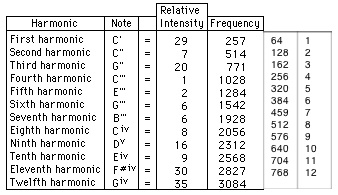
"Calling the intensity of the fundamental tone, in each case, 100, that of the second harmonic, when the string was simply pulled aside at a point 1/7th of its length from its end and then liberated, was found to be 56.1, or a little more than one-half. When the string was struck with the hammer of a pianoforte, whose contact with the string endured for 3/7ths of the period of vibration of the fundamental tone, the intensity of the same tone was 9. In this case the second harmonic was nearly quenched. When, however, the duration of contact was diminished to 3/20ths of the period of the fundamental, the intensity of the harmonic rose to 357; While, when the string was sharply struck with a very hard hammer, the intensity mounted to 505, or to more than quintuple that of the fundamental. [Yielding over-unity times 5]
"Pianoforte manufacturers have found that the most pleasing tone is excited by the middle strings of their instruments, when the point against which the hammer strikes is from 1/7th to 1/9th of the length of the wire from its extremity. Why should this be the case? Helmhotz has given the answer. Up to the tones which require these points as nodes the overtones all form chords with the fundamental; but the sixth and eighth overtones of the wire do not enter into such chords; they are dissonant tones, and hence the desirability of doing away with them. This is accomplished by making the point at which a node is required that on which the hammer falls. The possibility of the tone forming is thereby shut out, and its injurious effect is avoided." [John Tyndall, Sound; Longmans, Green, and Co., London, 1893]
ChatGPT explores Sweet VTA, Dynasphere Actuators, material and harmonic interactions and functional principles of Free Energy [2/10/25]: [1] https://chatgpt.com/share/67aa0596-f7a0-800d-944e-a45ba2a67f24
See Also
AI Interpretations of SVP
Additive and Subtractive Synthesis
Beat
Clang
Difference Tone
Differentiation
eleventh note
7.20 - Eleventh
dominant eleventh
Eleventh Harmonic
Overtones Developed Musically
Figure 8.5 - Summation Tones
Figure 8.6 - Difference Tones
Free Energy
Frequency Wavelength Light Energy
Harmonic
Harmonical ratio
Interval
Law of Harmonic Pitch
Law of Harmonic Vibrations
Overtone Series
Overtone
Resultant Tone
Summation Tone
Syntropy
Undertone
1.20 - Evolution and Devolution of Frequency
Power of Harmonics
9.8 - Spontaneous Creation of Harmonic Series
9.9 - Sympathy or Harmony Between Harmonics or Overtones
